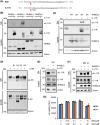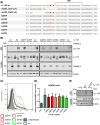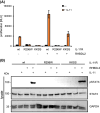Interleukin-11 (IL-11) receptor cleavage by the rhomboid protease RHBDL2 induces IL-11 trans-signaling
- PMID: 33566379
- PMCID: PMC12266321
- DOI: 10.1096/fj.202002087R
Interleukin-11 (IL-11) receptor cleavage by the rhomboid protease RHBDL2 induces IL-11 trans-signaling
Abstract
Interleukin-11 (IL-11) is a pleiotropic cytokine with both pro- and anti-inflammatory properties. It activates its target cells via binding to the membrane-bound IL-11 receptor (IL-11R), which then recruits a homodimer of the ubiquitously expressed, signal-transducing receptor gp130. Besides this classic signaling pathway, IL-11 can also bind to soluble forms of the IL-11R (sIL-11R), and IL-11/sIL-11R complexes activate cells via the induction of gp130 homodimerization (trans-signaling). We have previously reported that the metalloprotease ADAM10 cleaves the membrane-bound IL-11R and thereby generates sIL-11R. In this study, we identify the rhomboid intramembrane protease RHBDL2 as a so far unrecognized alternative sheddase that can efficiently trigger IL-11R secretion. We determine the cleavage site used by RHBDL2, which is located in the extracellular part of the receptor in close proximity to the plasma membrane, between Ala-370 and Ser-371. Furthermore, we identify critical amino acid residues within the transmembrane helix that are required for IL-11R proteolysis. We also show that ectopically expressed RHBDL2 is able to cleave the IL-11R within the early secretory pathway and not only at the plasma membrane, indicating that its subcellular localization plays a central role in controlling its activity. Moreover, RHBDL2-derived sIL-11R is biologically active and able to perform IL-11 trans-signaling. Finally, we show that the human mutation IL-11R-A370V does not impede IL-11 classic signaling, but prevents RHBDL2-mediated IL-11R cleavage.
Keywords: RHBDL2; cytokine; interleukin-11; protease; rhomboid.
© 2021 The Authors. The FASEB Journal published by Wiley Periodicals LLC on behalf of Federation of American Societies for Experimental Biology.
Conflict of interest statement
CG has received funding support from Corvidia Therapeutics (Waltham, MA, USA).
Figures






References
-
- Garbers C, Scheller J. Interleukin‐6 and interleukin‐11: same same but different. Biol Chem. 2013;394:1145‐1161. - PubMed
-
- Putoczki T, Ernst M. More than a sidekick: the IL‐6 family cytokine IL‐11 links inflammation to cancer. J Leukoc Biol. 2010;88:1109‐1117. - PubMed
-
- Garbers C, Hermanns H, Schaper F, et al. Plasticity and cross‐talk of Interleukin 6‐type cytokines. Cytokine Growth Factor Rev. 2012;23:85‐97. - PubMed
-
- Putoczki TL, Ernst M. IL‐11 signaling as a therapeutic target for cancer. Immunotherapy. 2015;7:441‐453. - PubMed
-
- Suen Y, Chang M, Lee SM, Buzby JS, Cairo MS. Regulation of interleukin‐11 protein and mRNA expression in neonatal and adult fibroblasts and endothelial cells. Blood. 1994;84:4125‐4134. - PubMed
Publication types
MeSH terms
Substances
LinkOut - more resources
Full Text Sources
Other Literature Sources
Molecular Biology Databases

